Court of Appeal Case: Skeleton Argument for Quid Land Ltd. v Hamilton
VerifiedAdded on 2023/01/10
|10
|2475
|81
Report
AI Summary
This skeleton argument addresses the case of Quid Land Ltd. v Mr. Hamilton, focusing on whether an advertisement constituted an offer or an invitation to treat. The document analyzes the arguments presented by the respondent, Mr. Hamilton, emphasizing that the advertisement for a sale with discounts was an offer, particularly because it specified a 'first come, first served' basis, removing the ambiguity of a general invitation to treat. The argument references case laws like Partridge v Crittenden, Pharmaceutical Society v Boots, and Carlill v Carbolic Smoke Ball Co to support the claim that the advertisement, under the given circumstances, constituted a valid offer that Mr. Hamilton accepted. The respondent's argument highlights the breach of contract by Quid Land Ltd. and supports the district judge's initial ruling in favor of Mr. Hamilton. The document concludes that the decision of the district judge should be upheld.

WORD
Paraphrase This Document
Need a fresh take? Get an instant paraphrase of this document with our AI Paraphraser
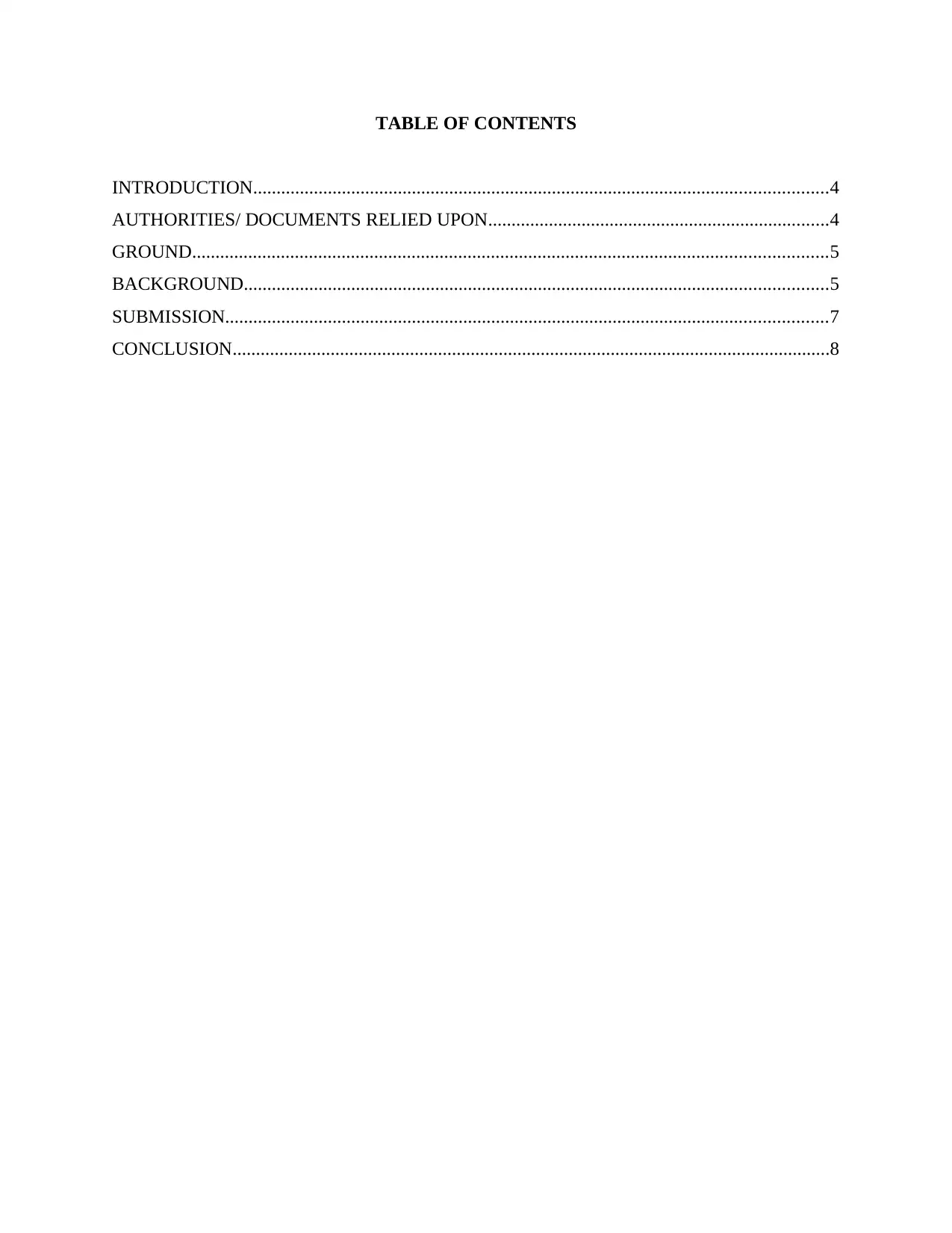
TABLE OF CONTENTS
INTRODUCTION...........................................................................................................................4
AUTHORITIES/ DOCUMENTS RELIED UPON.........................................................................4
GROUND........................................................................................................................................5
BACKGROUND.............................................................................................................................5
SUBMISSION.................................................................................................................................7
CONCLUSION................................................................................................................................8
INTRODUCTION...........................................................................................................................4
AUTHORITIES/ DOCUMENTS RELIED UPON.........................................................................4
GROUND........................................................................................................................................5
BACKGROUND.............................................................................................................................5
SUBMISSION.................................................................................................................................7
CONCLUSION................................................................................................................................8
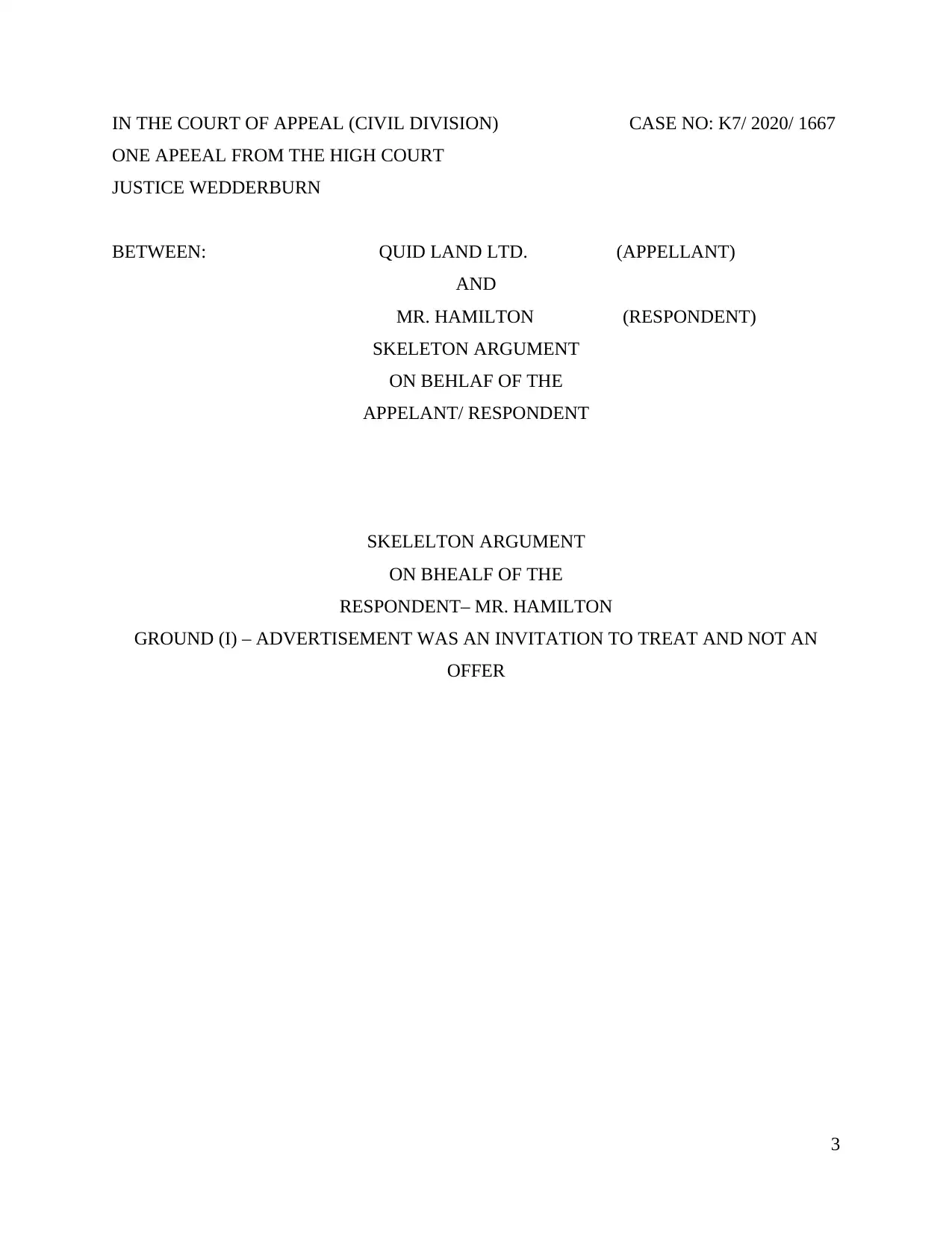
IN THE COURT OF APPEAL (CIVIL DIVISION) CASE NO: K7/ 2020/ 1667
ONE APEEAL FROM THE HIGH COURT
JUSTICE WEDDERBURN
BETWEEN: QUID LAND LTD. (APPELLANT)
AND
MR. HAMILTON (RESPONDENT)
SKELETON ARGUMENT
ON BEHLAF OF THE
APPELANT/ RESPONDENT
SKELELTON ARGUMENT
ON BHEALF OF THE
RESPONDENT– MR. HAMILTON
GROUND (I) – ADVERTISEMENT WAS AN INVITATION TO TREAT AND NOT AN
OFFER
3
ONE APEEAL FROM THE HIGH COURT
JUSTICE WEDDERBURN
BETWEEN: QUID LAND LTD. (APPELLANT)
AND
MR. HAMILTON (RESPONDENT)
SKELETON ARGUMENT
ON BEHLAF OF THE
APPELANT/ RESPONDENT
SKELELTON ARGUMENT
ON BHEALF OF THE
RESPONDENT– MR. HAMILTON
GROUND (I) – ADVERTISEMENT WAS AN INVITATION TO TREAT AND NOT AN
OFFER
3
⊘ This is a preview!⊘
Do you want full access?
Subscribe today to unlock all pages.

Trusted by 1+ million students worldwide
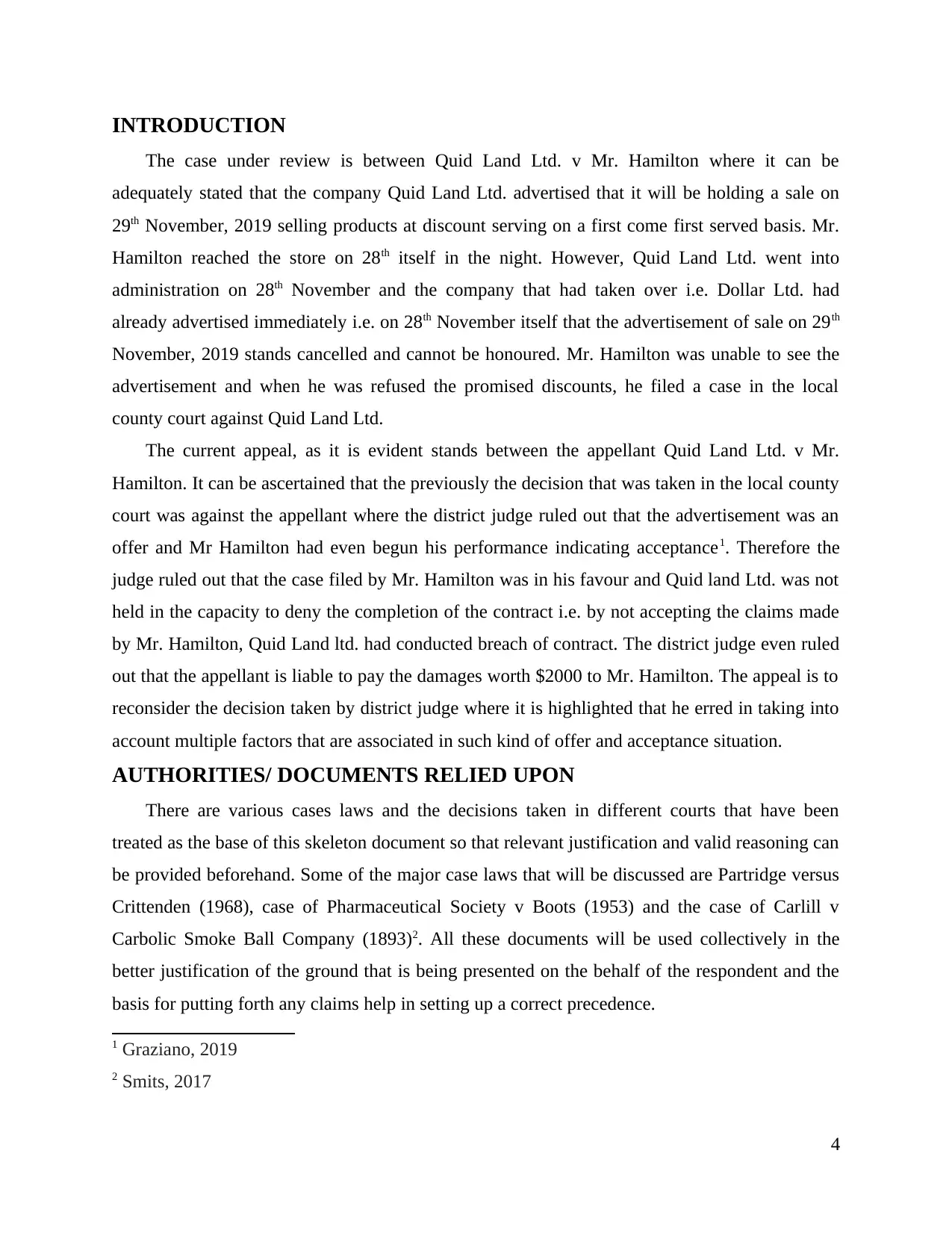
INTRODUCTION
The case under review is between Quid Land Ltd. v Mr. Hamilton where it can be
adequately stated that the company Quid Land Ltd. advertised that it will be holding a sale on
29th November, 2019 selling products at discount serving on a first come first served basis. Mr.
Hamilton reached the store on 28th itself in the night. However, Quid Land Ltd. went into
administration on 28th November and the company that had taken over i.e. Dollar Ltd. had
already advertised immediately i.e. on 28th November itself that the advertisement of sale on 29th
November, 2019 stands cancelled and cannot be honoured. Mr. Hamilton was unable to see the
advertisement and when he was refused the promised discounts, he filed a case in the local
county court against Quid Land Ltd.
The current appeal, as it is evident stands between the appellant Quid Land Ltd. v Mr.
Hamilton. It can be ascertained that the previously the decision that was taken in the local county
court was against the appellant where the district judge ruled out that the advertisement was an
offer and Mr Hamilton had even begun his performance indicating acceptance1. Therefore the
judge ruled out that the case filed by Mr. Hamilton was in his favour and Quid land Ltd. was not
held in the capacity to deny the completion of the contract i.e. by not accepting the claims made
by Mr. Hamilton, Quid Land ltd. had conducted breach of contract. The district judge even ruled
out that the appellant is liable to pay the damages worth $2000 to Mr. Hamilton. The appeal is to
reconsider the decision taken by district judge where it is highlighted that he erred in taking into
account multiple factors that are associated in such kind of offer and acceptance situation.
AUTHORITIES/ DOCUMENTS RELIED UPON
There are various cases laws and the decisions taken in different courts that have been
treated as the base of this skeleton document so that relevant justification and valid reasoning can
be provided beforehand. Some of the major case laws that will be discussed are Partridge versus
Crittenden (1968), case of Pharmaceutical Society v Boots (1953) and the case of Carlill v
Carbolic Smoke Ball Company (1893)2. All these documents will be used collectively in the
better justification of the ground that is being presented on the behalf of the respondent and the
basis for putting forth any claims help in setting up a correct precedence.
1 Graziano, 2019
2 Smits, 2017
4
The case under review is between Quid Land Ltd. v Mr. Hamilton where it can be
adequately stated that the company Quid Land Ltd. advertised that it will be holding a sale on
29th November, 2019 selling products at discount serving on a first come first served basis. Mr.
Hamilton reached the store on 28th itself in the night. However, Quid Land Ltd. went into
administration on 28th November and the company that had taken over i.e. Dollar Ltd. had
already advertised immediately i.e. on 28th November itself that the advertisement of sale on 29th
November, 2019 stands cancelled and cannot be honoured. Mr. Hamilton was unable to see the
advertisement and when he was refused the promised discounts, he filed a case in the local
county court against Quid Land Ltd.
The current appeal, as it is evident stands between the appellant Quid Land Ltd. v Mr.
Hamilton. It can be ascertained that the previously the decision that was taken in the local county
court was against the appellant where the district judge ruled out that the advertisement was an
offer and Mr Hamilton had even begun his performance indicating acceptance1. Therefore the
judge ruled out that the case filed by Mr. Hamilton was in his favour and Quid land Ltd. was not
held in the capacity to deny the completion of the contract i.e. by not accepting the claims made
by Mr. Hamilton, Quid Land ltd. had conducted breach of contract. The district judge even ruled
out that the appellant is liable to pay the damages worth $2000 to Mr. Hamilton. The appeal is to
reconsider the decision taken by district judge where it is highlighted that he erred in taking into
account multiple factors that are associated in such kind of offer and acceptance situation.
AUTHORITIES/ DOCUMENTS RELIED UPON
There are various cases laws and the decisions taken in different courts that have been
treated as the base of this skeleton document so that relevant justification and valid reasoning can
be provided beforehand. Some of the major case laws that will be discussed are Partridge versus
Crittenden (1968), case of Pharmaceutical Society v Boots (1953) and the case of Carlill v
Carbolic Smoke Ball Company (1893)2. All these documents will be used collectively in the
better justification of the ground that is being presented on the behalf of the respondent and the
basis for putting forth any claims help in setting up a correct precedence.
1 Graziano, 2019
2 Smits, 2017
4
Paraphrase This Document
Need a fresh take? Get an instant paraphrase of this document with our AI Paraphraser
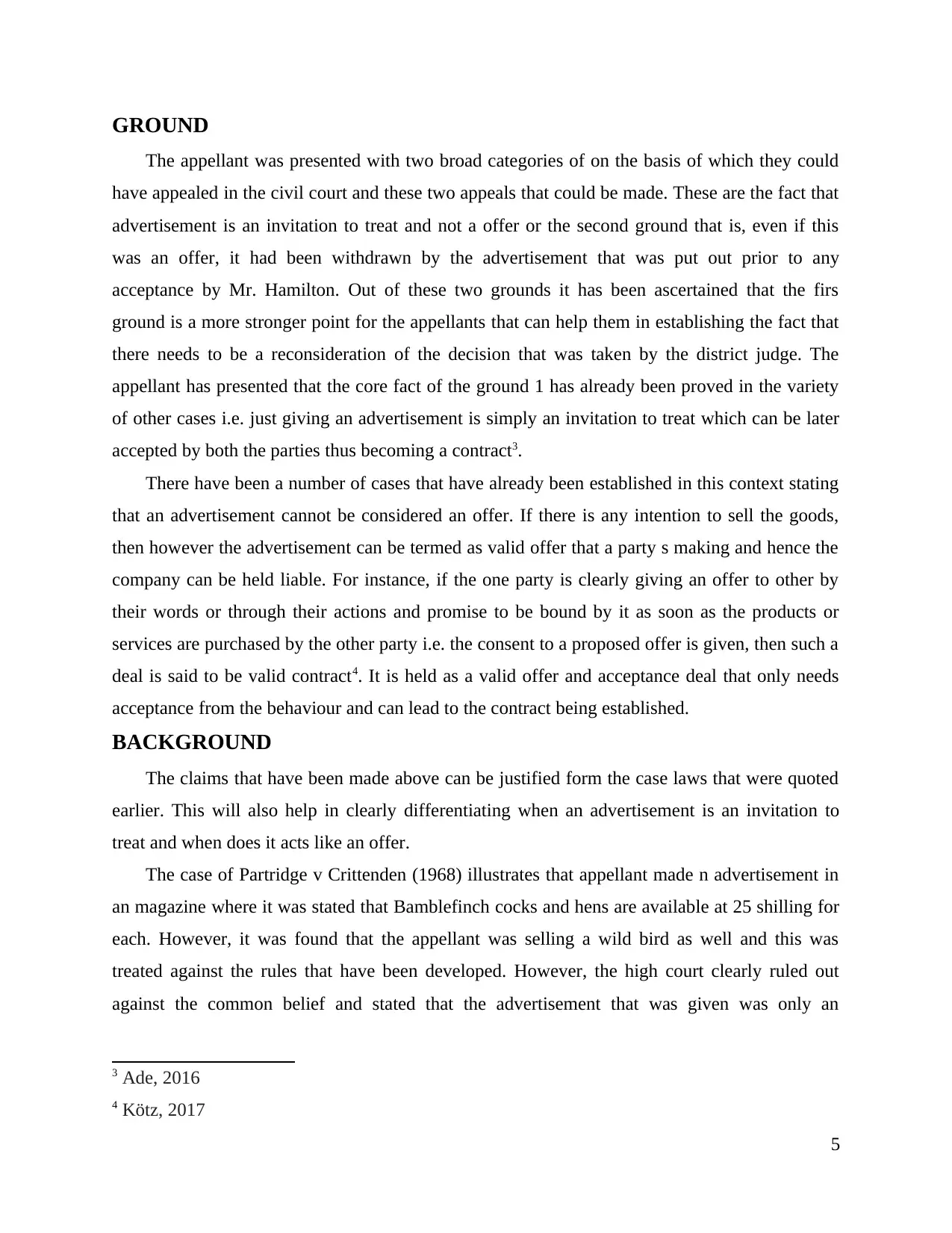
GROUND
The appellant was presented with two broad categories of on the basis of which they could
have appealed in the civil court and these two appeals that could be made. These are the fact that
advertisement is an invitation to treat and not a offer or the second ground that is, even if this
was an offer, it had been withdrawn by the advertisement that was put out prior to any
acceptance by Mr. Hamilton. Out of these two grounds it has been ascertained that the firs
ground is a more stronger point for the appellants that can help them in establishing the fact that
there needs to be a reconsideration of the decision that was taken by the district judge. The
appellant has presented that the core fact of the ground 1 has already been proved in the variety
of other cases i.e. just giving an advertisement is simply an invitation to treat which can be later
accepted by both the parties thus becoming a contract3.
There have been a number of cases that have already been established in this context stating
that an advertisement cannot be considered an offer. If there is any intention to sell the goods,
then however the advertisement can be termed as valid offer that a party s making and hence the
company can be held liable. For instance, if the one party is clearly giving an offer to other by
their words or through their actions and promise to be bound by it as soon as the products or
services are purchased by the other party i.e. the consent to a proposed offer is given, then such a
deal is said to be valid contract4. It is held as a valid offer and acceptance deal that only needs
acceptance from the behaviour and can lead to the contract being established.
BACKGROUND
The claims that have been made above can be justified form the case laws that were quoted
earlier. This will also help in clearly differentiating when an advertisement is an invitation to
treat and when does it acts like an offer.
The case of Partridge v Crittenden (1968) illustrates that appellant made n advertisement in
an magazine where it was stated that Bamblefinch cocks and hens are available at 25 shilling for
each. However, it was found that the appellant was selling a wild bird as well and this was
treated against the rules that have been developed. However, the high court clearly ruled out
against the common belief and stated that the advertisement that was given was only an
3 Ade, 2016
4 Kötz, 2017
5
The appellant was presented with two broad categories of on the basis of which they could
have appealed in the civil court and these two appeals that could be made. These are the fact that
advertisement is an invitation to treat and not a offer or the second ground that is, even if this
was an offer, it had been withdrawn by the advertisement that was put out prior to any
acceptance by Mr. Hamilton. Out of these two grounds it has been ascertained that the firs
ground is a more stronger point for the appellants that can help them in establishing the fact that
there needs to be a reconsideration of the decision that was taken by the district judge. The
appellant has presented that the core fact of the ground 1 has already been proved in the variety
of other cases i.e. just giving an advertisement is simply an invitation to treat which can be later
accepted by both the parties thus becoming a contract3.
There have been a number of cases that have already been established in this context stating
that an advertisement cannot be considered an offer. If there is any intention to sell the goods,
then however the advertisement can be termed as valid offer that a party s making and hence the
company can be held liable. For instance, if the one party is clearly giving an offer to other by
their words or through their actions and promise to be bound by it as soon as the products or
services are purchased by the other party i.e. the consent to a proposed offer is given, then such a
deal is said to be valid contract4. It is held as a valid offer and acceptance deal that only needs
acceptance from the behaviour and can lead to the contract being established.
BACKGROUND
The claims that have been made above can be justified form the case laws that were quoted
earlier. This will also help in clearly differentiating when an advertisement is an invitation to
treat and when does it acts like an offer.
The case of Partridge v Crittenden (1968) illustrates that appellant made n advertisement in
an magazine where it was stated that Bamblefinch cocks and hens are available at 25 shilling for
each. However, it was found that the appellant was selling a wild bird as well and this was
treated against the rules that have been developed. However, the high court clearly ruled out
against the common belief and stated that the advertisement that was given was only an
3 Ade, 2016
4 Kötz, 2017
5
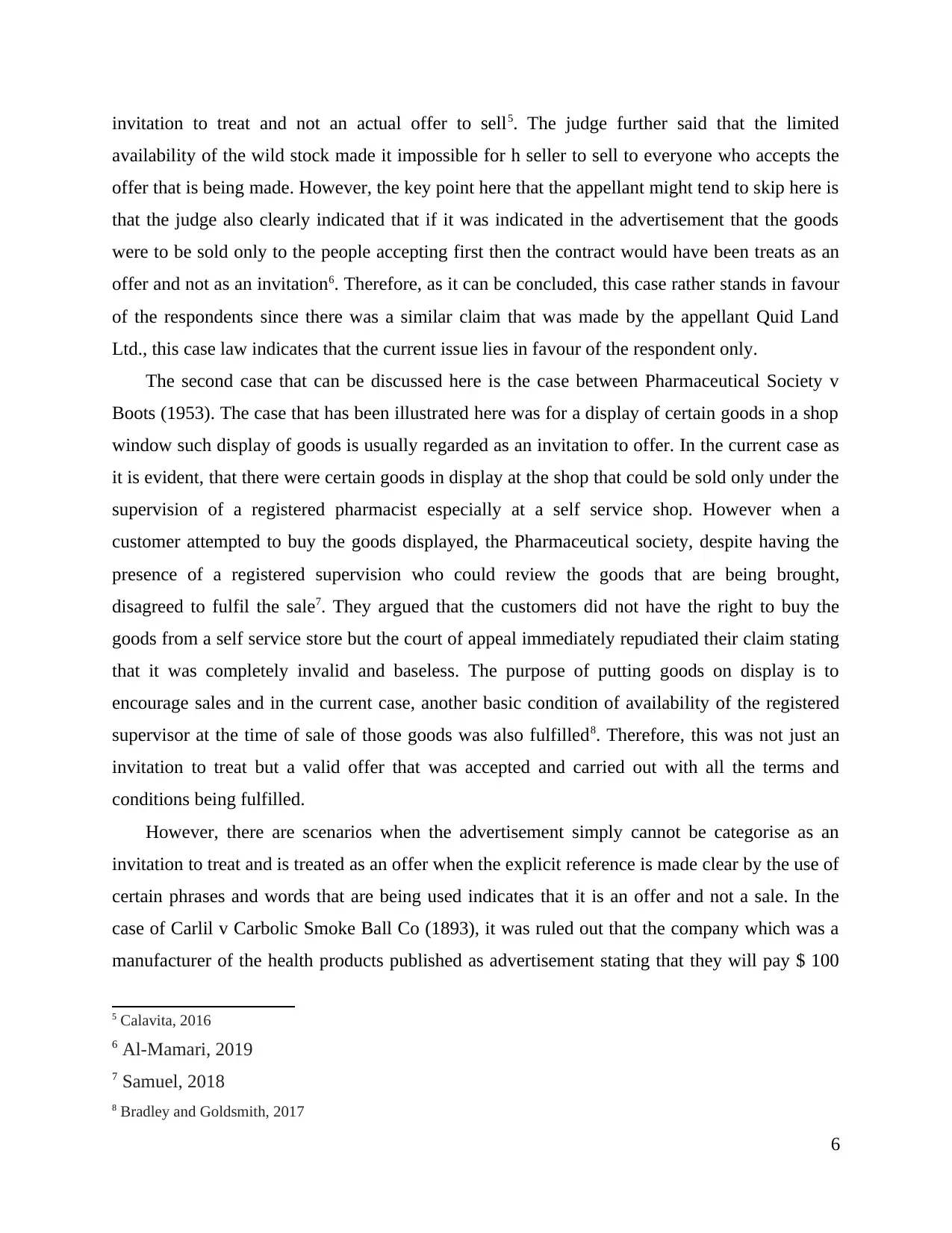
invitation to treat and not an actual offer to sell5. The judge further said that the limited
availability of the wild stock made it impossible for h seller to sell to everyone who accepts the
offer that is being made. However, the key point here that the appellant might tend to skip here is
that the judge also clearly indicated that if it was indicated in the advertisement that the goods
were to be sold only to the people accepting first then the contract would have been treats as an
offer and not as an invitation6. Therefore, as it can be concluded, this case rather stands in favour
of the respondents since there was a similar claim that was made by the appellant Quid Land
Ltd., this case law indicates that the current issue lies in favour of the respondent only.
The second case that can be discussed here is the case between Pharmaceutical Society v
Boots (1953). The case that has been illustrated here was for a display of certain goods in a shop
window such display of goods is usually regarded as an invitation to offer. In the current case as
it is evident, that there were certain goods in display at the shop that could be sold only under the
supervision of a registered pharmacist especially at a self service shop. However when a
customer attempted to buy the goods displayed, the Pharmaceutical society, despite having the
presence of a registered supervision who could review the goods that are being brought,
disagreed to fulfil the sale7. They argued that the customers did not have the right to buy the
goods from a self service store but the court of appeal immediately repudiated their claim stating
that it was completely invalid and baseless. The purpose of putting goods on display is to
encourage sales and in the current case, another basic condition of availability of the registered
supervisor at the time of sale of those goods was also fulfilled8. Therefore, this was not just an
invitation to treat but a valid offer that was accepted and carried out with all the terms and
conditions being fulfilled.
However, there are scenarios when the advertisement simply cannot be categorise as an
invitation to treat and is treated as an offer when the explicit reference is made clear by the use of
certain phrases and words that are being used indicates that it is an offer and not a sale. In the
case of Carlil v Carbolic Smoke Ball Co (1893), it was ruled out that the company which was a
manufacturer of the health products published as advertisement stating that they will pay $ 100
5 Calavita, 2016
6 Al-Mamari, 2019
7 Samuel, 2018
8 Bradley and Goldsmith, 2017
6
availability of the wild stock made it impossible for h seller to sell to everyone who accepts the
offer that is being made. However, the key point here that the appellant might tend to skip here is
that the judge also clearly indicated that if it was indicated in the advertisement that the goods
were to be sold only to the people accepting first then the contract would have been treats as an
offer and not as an invitation6. Therefore, as it can be concluded, this case rather stands in favour
of the respondents since there was a similar claim that was made by the appellant Quid Land
Ltd., this case law indicates that the current issue lies in favour of the respondent only.
The second case that can be discussed here is the case between Pharmaceutical Society v
Boots (1953). The case that has been illustrated here was for a display of certain goods in a shop
window such display of goods is usually regarded as an invitation to offer. In the current case as
it is evident, that there were certain goods in display at the shop that could be sold only under the
supervision of a registered pharmacist especially at a self service shop. However when a
customer attempted to buy the goods displayed, the Pharmaceutical society, despite having the
presence of a registered supervision who could review the goods that are being brought,
disagreed to fulfil the sale7. They argued that the customers did not have the right to buy the
goods from a self service store but the court of appeal immediately repudiated their claim stating
that it was completely invalid and baseless. The purpose of putting goods on display is to
encourage sales and in the current case, another basic condition of availability of the registered
supervisor at the time of sale of those goods was also fulfilled8. Therefore, this was not just an
invitation to treat but a valid offer that was accepted and carried out with all the terms and
conditions being fulfilled.
However, there are scenarios when the advertisement simply cannot be categorise as an
invitation to treat and is treated as an offer when the explicit reference is made clear by the use of
certain phrases and words that are being used indicates that it is an offer and not a sale. In the
case of Carlil v Carbolic Smoke Ball Co (1893), it was ruled out that the company which was a
manufacturer of the health products published as advertisement stating that they will pay $ 100
5 Calavita, 2016
6 Al-Mamari, 2019
7 Samuel, 2018
8 Bradley and Goldsmith, 2017
6
⊘ This is a preview!⊘
Do you want full access?
Subscribe today to unlock all pages.

Trusted by 1+ million students worldwide
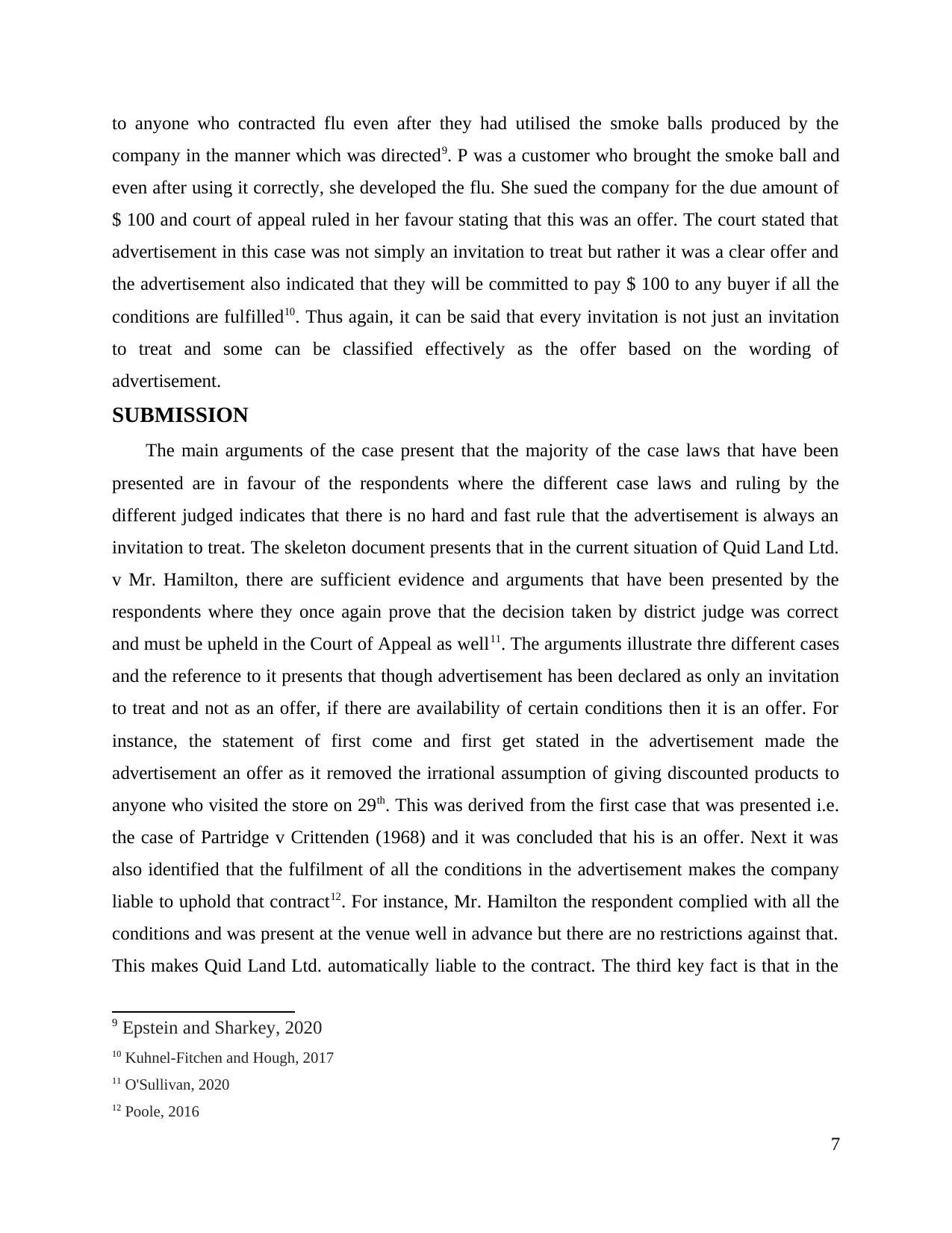
to anyone who contracted flu even after they had utilised the smoke balls produced by the
company in the manner which was directed9. P was a customer who brought the smoke ball and
even after using it correctly, she developed the flu. She sued the company for the due amount of
$ 100 and court of appeal ruled in her favour stating that this was an offer. The court stated that
advertisement in this case was not simply an invitation to treat but rather it was a clear offer and
the advertisement also indicated that they will be committed to pay $ 100 to any buyer if all the
conditions are fulfilled10. Thus again, it can be said that every invitation is not just an invitation
to treat and some can be classified effectively as the offer based on the wording of
advertisement.
SUBMISSION
The main arguments of the case present that the majority of the case laws that have been
presented are in favour of the respondents where the different case laws and ruling by the
different judged indicates that there is no hard and fast rule that the advertisement is always an
invitation to treat. The skeleton document presents that in the current situation of Quid Land Ltd.
v Mr. Hamilton, there are sufficient evidence and arguments that have been presented by the
respondents where they once again prove that the decision taken by district judge was correct
and must be upheld in the Court of Appeal as well11. The arguments illustrate thre different cases
and the reference to it presents that though advertisement has been declared as only an invitation
to treat and not as an offer, if there are availability of certain conditions then it is an offer. For
instance, the statement of first come and first get stated in the advertisement made the
advertisement an offer as it removed the irrational assumption of giving discounted products to
anyone who visited the store on 29th. This was derived from the first case that was presented i.e.
the case of Partridge v Crittenden (1968) and it was concluded that his is an offer. Next it was
also identified that the fulfilment of all the conditions in the advertisement makes the company
liable to uphold that contract12. For instance, Mr. Hamilton the respondent complied with all the
conditions and was present at the venue well in advance but there are no restrictions against that.
This makes Quid Land Ltd. automatically liable to the contract. The third key fact is that in the
9 Epstein and Sharkey, 2020
10 Kuhnel-Fitchen and Hough, 2017
11 O'Sullivan, 2020
12 Poole, 2016
7
company in the manner which was directed9. P was a customer who brought the smoke ball and
even after using it correctly, she developed the flu. She sued the company for the due amount of
$ 100 and court of appeal ruled in her favour stating that this was an offer. The court stated that
advertisement in this case was not simply an invitation to treat but rather it was a clear offer and
the advertisement also indicated that they will be committed to pay $ 100 to any buyer if all the
conditions are fulfilled10. Thus again, it can be said that every invitation is not just an invitation
to treat and some can be classified effectively as the offer based on the wording of
advertisement.
SUBMISSION
The main arguments of the case present that the majority of the case laws that have been
presented are in favour of the respondents where the different case laws and ruling by the
different judged indicates that there is no hard and fast rule that the advertisement is always an
invitation to treat. The skeleton document presents that in the current situation of Quid Land Ltd.
v Mr. Hamilton, there are sufficient evidence and arguments that have been presented by the
respondents where they once again prove that the decision taken by district judge was correct
and must be upheld in the Court of Appeal as well11. The arguments illustrate thre different cases
and the reference to it presents that though advertisement has been declared as only an invitation
to treat and not as an offer, if there are availability of certain conditions then it is an offer. For
instance, the statement of first come and first get stated in the advertisement made the
advertisement an offer as it removed the irrational assumption of giving discounted products to
anyone who visited the store on 29th. This was derived from the first case that was presented i.e.
the case of Partridge v Crittenden (1968) and it was concluded that his is an offer. Next it was
also identified that the fulfilment of all the conditions in the advertisement makes the company
liable to uphold that contract12. For instance, Mr. Hamilton the respondent complied with all the
conditions and was present at the venue well in advance but there are no restrictions against that.
This makes Quid Land Ltd. automatically liable to the contract. The third key fact is that in the
9 Epstein and Sharkey, 2020
10 Kuhnel-Fitchen and Hough, 2017
11 O'Sullivan, 2020
12 Poole, 2016
7
Paraphrase This Document
Need a fresh take? Get an instant paraphrase of this document with our AI Paraphraser
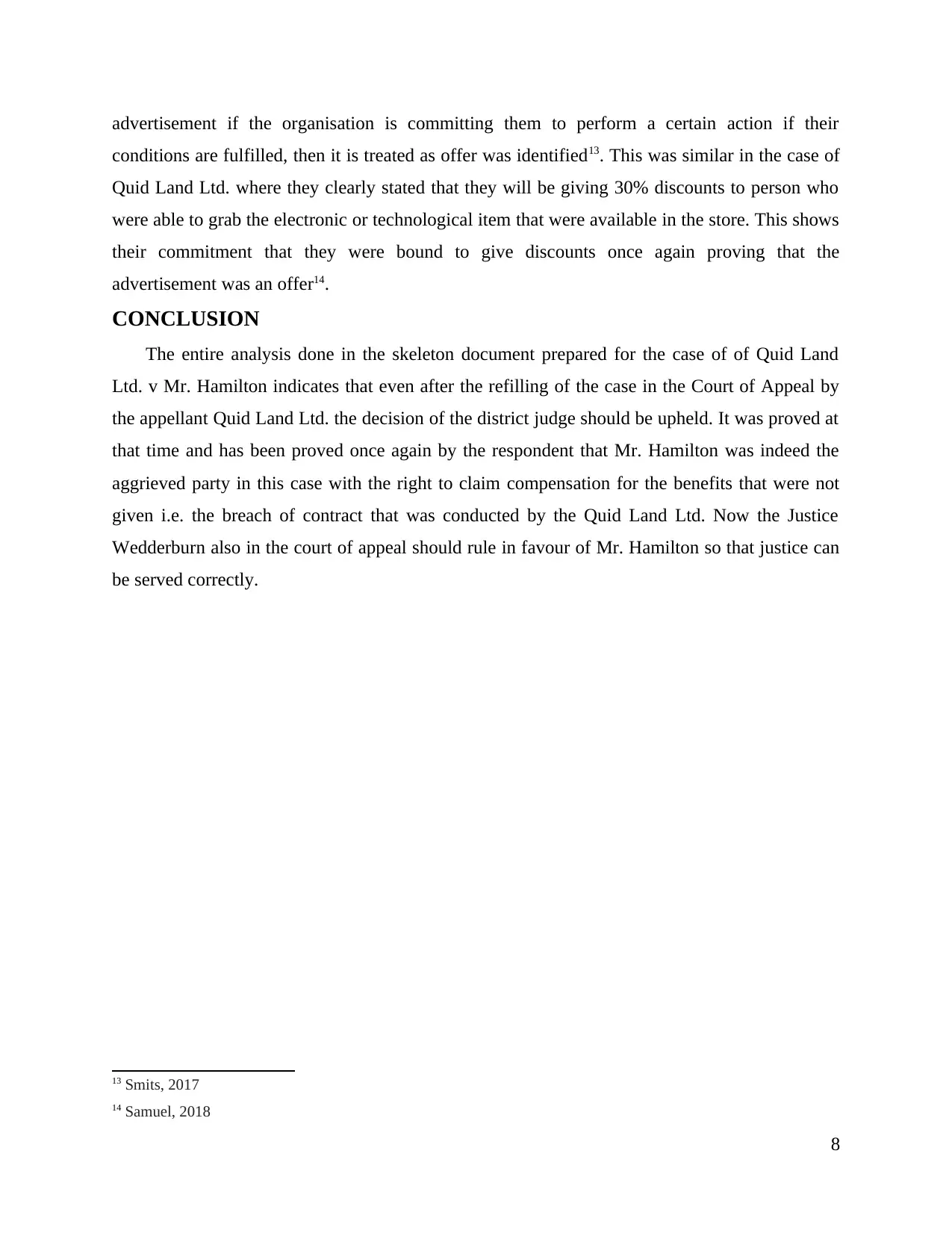
advertisement if the organisation is committing them to perform a certain action if their
conditions are fulfilled, then it is treated as offer was identified13. This was similar in the case of
Quid Land Ltd. where they clearly stated that they will be giving 30% discounts to person who
were able to grab the electronic or technological item that were available in the store. This shows
their commitment that they were bound to give discounts once again proving that the
advertisement was an offer14.
CONCLUSION
The entire analysis done in the skeleton document prepared for the case of of Quid Land
Ltd. v Mr. Hamilton indicates that even after the refilling of the case in the Court of Appeal by
the appellant Quid Land Ltd. the decision of the district judge should be upheld. It was proved at
that time and has been proved once again by the respondent that Mr. Hamilton was indeed the
aggrieved party in this case with the right to claim compensation for the benefits that were not
given i.e. the breach of contract that was conducted by the Quid Land Ltd. Now the Justice
Wedderburn also in the court of appeal should rule in favour of Mr. Hamilton so that justice can
be served correctly.
13 Smits, 2017
14 Samuel, 2018
8
conditions are fulfilled, then it is treated as offer was identified13. This was similar in the case of
Quid Land Ltd. where they clearly stated that they will be giving 30% discounts to person who
were able to grab the electronic or technological item that were available in the store. This shows
their commitment that they were bound to give discounts once again proving that the
advertisement was an offer14.
CONCLUSION
The entire analysis done in the skeleton document prepared for the case of of Quid Land
Ltd. v Mr. Hamilton indicates that even after the refilling of the case in the Court of Appeal by
the appellant Quid Land Ltd. the decision of the district judge should be upheld. It was proved at
that time and has been proved once again by the respondent that Mr. Hamilton was indeed the
aggrieved party in this case with the right to claim compensation for the benefits that were not
given i.e. the breach of contract that was conducted by the Quid Land Ltd. Now the Justice
Wedderburn also in the court of appeal should rule in favour of Mr. Hamilton so that justice can
be served correctly.
13 Smits, 2017
14 Samuel, 2018
8
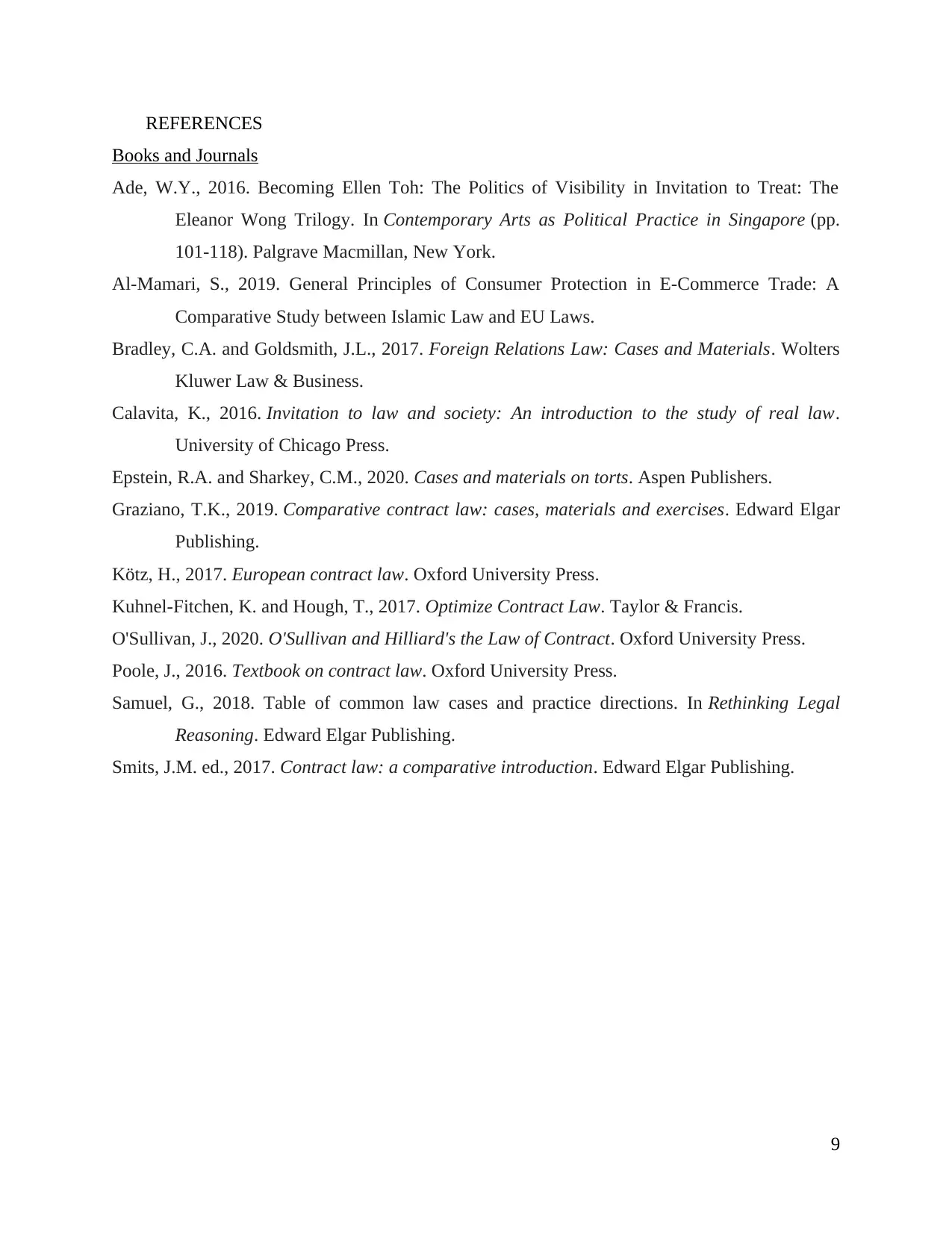
REFERENCES
Books and Journals
Ade, W.Y., 2016. Becoming Ellen Toh: The Politics of Visibility in Invitation to Treat: The
Eleanor Wong Trilogy. In Contemporary Arts as Political Practice in Singapore (pp.
101-118). Palgrave Macmillan, New York.
Al-Mamari, S., 2019. General Principles of Consumer Protection in E-Commerce Trade: A
Comparative Study between Islamic Law and EU Laws.
Bradley, C.A. and Goldsmith, J.L., 2017. Foreign Relations Law: Cases and Materials. Wolters
Kluwer Law & Business.
Calavita, K., 2016. Invitation to law and society: An introduction to the study of real law.
University of Chicago Press.
Epstein, R.A. and Sharkey, C.M., 2020. Cases and materials on torts. Aspen Publishers.
Graziano, T.K., 2019. Comparative contract law: cases, materials and exercises. Edward Elgar
Publishing.
Kötz, H., 2017. European contract law. Oxford University Press.
Kuhnel-Fitchen, K. and Hough, T., 2017. Optimize Contract Law. Taylor & Francis.
O'Sullivan, J., 2020. O'Sullivan and Hilliard's the Law of Contract. Oxford University Press.
Poole, J., 2016. Textbook on contract law. Oxford University Press.
Samuel, G., 2018. Table of common law cases and practice directions. In Rethinking Legal
Reasoning. Edward Elgar Publishing.
Smits, J.M. ed., 2017. Contract law: a comparative introduction. Edward Elgar Publishing.
9
Books and Journals
Ade, W.Y., 2016. Becoming Ellen Toh: The Politics of Visibility in Invitation to Treat: The
Eleanor Wong Trilogy. In Contemporary Arts as Political Practice in Singapore (pp.
101-118). Palgrave Macmillan, New York.
Al-Mamari, S., 2019. General Principles of Consumer Protection in E-Commerce Trade: A
Comparative Study between Islamic Law and EU Laws.
Bradley, C.A. and Goldsmith, J.L., 2017. Foreign Relations Law: Cases and Materials. Wolters
Kluwer Law & Business.
Calavita, K., 2016. Invitation to law and society: An introduction to the study of real law.
University of Chicago Press.
Epstein, R.A. and Sharkey, C.M., 2020. Cases and materials on torts. Aspen Publishers.
Graziano, T.K., 2019. Comparative contract law: cases, materials and exercises. Edward Elgar
Publishing.
Kötz, H., 2017. European contract law. Oxford University Press.
Kuhnel-Fitchen, K. and Hough, T., 2017. Optimize Contract Law. Taylor & Francis.
O'Sullivan, J., 2020. O'Sullivan and Hilliard's the Law of Contract. Oxford University Press.
Poole, J., 2016. Textbook on contract law. Oxford University Press.
Samuel, G., 2018. Table of common law cases and practice directions. In Rethinking Legal
Reasoning. Edward Elgar Publishing.
Smits, J.M. ed., 2017. Contract law: a comparative introduction. Edward Elgar Publishing.
9
⊘ This is a preview!⊘
Do you want full access?
Subscribe today to unlock all pages.

Trusted by 1+ million students worldwide

10
1 out of 10
Related Documents
Your All-in-One AI-Powered Toolkit for Academic Success.
+13062052269
info@desklib.com
Available 24*7 on WhatsApp / Email
![[object Object]](/_next/static/media/star-bottom.7253800d.svg)
Unlock your academic potential
Copyright © 2020–2025 A2Z Services. All Rights Reserved. Developed and managed by ZUCOL.




